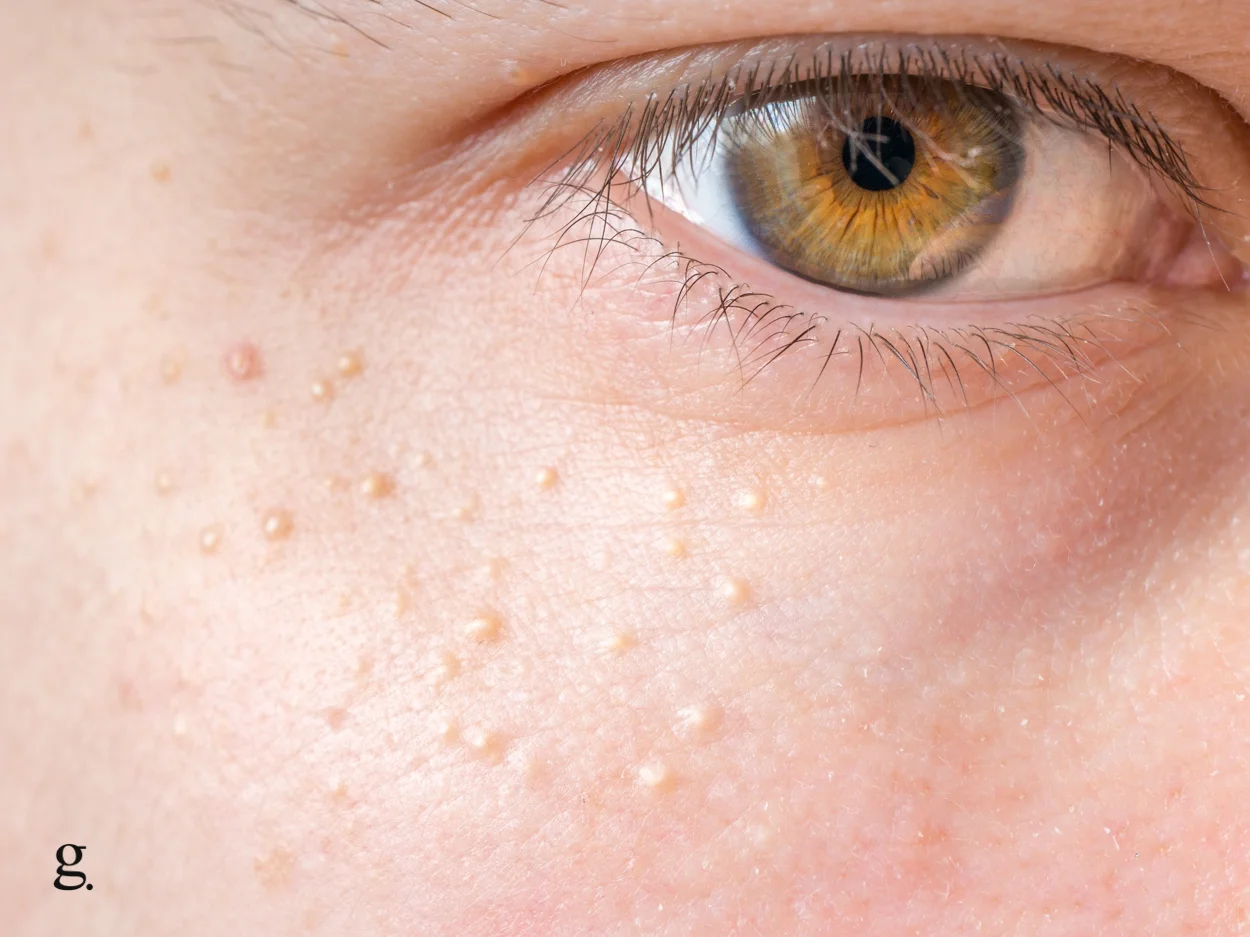What exactly is bumpy skin
Bumpy skin can refer to a variety of different textures and conditions. It can be dry and flaky, or oily and covered in pimples. It can be rough or smooth, itchy or painless. But in short, bumpy skin is any skin that is not perfectly smooth.
It’s important to note that there are lots of conditions that can cause bumps on your skin; if you’re worried, always consult with a dermatologist.
Otherwise, if you’re having your day ruined by bumpy and unruly skin– we’ve listed the main culprits below, along with ways to get rid of them.
The most common causes of bumpy skin texture
Below we’ve listed the most typical causes of bumpy skin, and how to get rid of them:
Genetics
If you have bumps on your skin, then it is likely just generally uneven skin texture; it’s a genetic thing and is nothing to worry about. Some people are blessed with smooth and flawless skin, others naturally have bumps, grooves and ridges on their skin surface.
How to get rid of bumps caused by genetically uneven skin texture
There are a few things you can do to improve the appearance of your skin:
- Exfoliate regularly – This will help to slough off dead skin cells and give your skin a more even texture.
- Use a moisturiser – This will help to hydrate the skin and make it appear plumper and smoother.
Fungal infection
Fungal infections are also a common cause of small bumps on the surface of the skin.
These infections are usually caused by a type of fungus called Candida, which is found naturally in your body. However, when the fungus overgrows, it can cause an infection.
The most common symptoms of a fungal infection include bumpy skin surface, itchiness, redness, and peeling of the skin.
How to get rid of bumps caused by fungal infections
Fungal infections can be treated with antifungal creams or oral medications. However, they often come back after treatment and can be difficult to get rid of completely. With that being said, you can factor in anti-fungal skincare products into your daily routine to help keep it at bay if you find that you’re regularly experiencing fungal infections.
To prevent fungal infections from occurring, it is important to keep the skin clean and most importantly, dry.
Additionally, wearing loose-fitting clothes to prevent excess sweating, and avoiding contact with people who have skin infections can help to reduce the risk of developing a fungal infection yourself.
Sebaceous hyperplasia
Sebaceous hyperplasia is a common and benign skin condition that results in the overgrowth of sebaceous glands. These glands are responsible for producing sebum, the oily substance that helps to keep the skin moist.
In people with sebaceous hyperplasia, the glands become enlarged and produce too much sebum. This can cause small bumps on the surface of the skin.
The bumps are usually yellow or white in colour and have a waxy or greasy texture, and are often mistaken for pimples or warts. Sebaceous hyperplasia is most commonly found on the face, but it can also occur on the chest, back, and shoulders.
The condition is more common in middle-aged or older adults. It is not contagious and does not usually cause any pain or discomfort. Although it’s is harmless, many people choose to treat it for cosmetic reasons.
How to get rid of bumps caused by Sebaceous Hyperplasia
Treatment options include topical creams, laser therapy, and cryotherapy (freezing).
Milia
Milia are small, white bumps that usually form around the eyes. They are caused by a build-up of dead skin cells and sebum in tiny pockets on the surface of the skin. Milia are very common and do not usually cause any pain or discomfort. However, many people choose to remove them for cosmetic reasons.
How to get rid of bumps caused by Milia
Milia can be removed by a doctor or dermatologist using a sterile needle or blade. The procedure is quick and relatively painless. Bare in mind, there will be a period of time required for recovery.
Keratosis pilaris
Keratosis pilaris (also known as chicken skin) is a common skin condition that causes small, hard bumps to form on the skin. These bumps are usually red, white, or yellow in colour and often have a “sandpaper-like” texture.
They typically occur on the upper arms, thighs, and cheeks.
How to get rid of bumps caused by Keratosis Pilaris
There is no cure for keratosis pilaris, but there are a few treatments that can help to improve the appearance of the skin. These include topical creams and lotions, exfoliation, and laser therapy.
Allergic reactions
Allergic reactions can often cause small bumps to form on the skin. These bumps are usually itchy and may be accompanied by other symptoms, such as redness and swelling, and hives. Allergic reactions can be triggered by a variety of things, such as eating certain foods, taking certain medications, and being exposed to pollen and pets.
How to get rid of bumps caused by an allergic reaction
The good news is that there are ways to treat allergic skin reactions and get relief from itching and swelling. Oral or topical antihistamines can be effective in treating mild reactions.
If your reaction is more severe, you may need to seek medical assistance. In either case, it’s important to avoid scratching the affected area, as this can cause further irritation and even lead to infection. With proper treatment, most allergic skin reactions will eventually resolve on their own, and your skin texture will revert back to normal.
Inflamed hair follicles (Folliculitis)
Folliculitis is a condition that can cause small bumps to form on the surface of the skin. The bumps are usually red and inflamed, and they may be filled with pus.
The condition is caused by an overgrowth of bacteria in the hair follicles. When the bacteria get into the follicles, they can cause an infection. This can lead to the formation of pimples or pus-filled bumps.
How to calm down inflamed hair follicles
Folliculitis is often treated with antibiotics, which is why we’d always recommend you visit your doctor if you think you have Folliculitis.
Certain home remedies such as apple cider vinegar or tea tree oil may also help reduce discomfort.
Acne
Most people have experienced acne at some point in their lives. Acne is a common skin condition that results in various types of blemishes. While acne is often thought of as a teenage problem, it can and does affect people of all ages.
One of the most common misconceptions about acne is that it is caused by dirt or poor hygiene.
In reality, acne is often genetic and caused by clogged pores. The blocking is due to a combination of factors, including excess oil production, bacteria, and excess dead skin cells on the skin’s surface.
How to get rid of bumps caused by Acne
While there are many treatments available for acne, the best way to prevent it is to keep your face clean and maintain a regular exfoliation routine. If this doesn’t help, there are medications that can, so visit your dermatologist!
Scars
Scars can cause bumps on the surface of the skin for a few different reasons. First, when the skin is damaged, it heals by creating new collagen fibres. However, these fibres are often thicker and not as evenly spaced as the original fibres. As a result, they can create a raised area on the surface of the skin.
In addition, scars often have a different colour or texture than the surrounding skin, which can also make them more noticeable.
Finally, scars can cause irritated bumps if they become infected or if they rub against clothing or other surfaces.
How to get rid of bumps caused by scars
If your bumpy and uneven skin texture is being caused by scar tissue, there’s really only one way to get rid of it, and that’s to get the scar removed.
Professional treatments for scar removal include laser therapy and microdermabrasion.
Laser therapy works by targeting the melanin in the skin, breaking up the pigment and making scars less visible. Microdermabrasion is a type of exfoliation that removes the top layer of skin, revealing the newer and unscarred skin underneath.
Boils
Boils are a skin condition that occurs when a hair follicle or sweat gland becomes infected. The infection causes the area to fill with pus, causing a red, painful bump to form.
Sometimes, the infection can spread to nearby tissue, causing the surface of the skin to become bumpy, red and uneven. Boils are most commonly found on the face, neck, armpits and buttocks.
How to get rid of bumps caused by boils
They can be treated at home with warm compresses, but more severe cases may require antibiotics. In rare cases, boils can lead to serious complications, such as blood poisoning or cellulitis, so visit your doctor if you’ve got a bad boil – and absolutely do not try to pop it yourself!
Cysts
Cysts are closed capsules or sacs that are filled with pus, fluid, or other material. They can occur anywhere on the body but are most common on the face, neck, back, or buttocks.
Cysts can range in size from a small bump to a large mass. Cysts can be caused by infection, inflammation, or blockages in the body’s drainage system. They are often benign and do not require treatment, however, they can be unsightly and cause the surface of the skin to become bumpy and uneven.
How to get rid of cysts
If you have a cyst that is causing you discomfort or concern, it is best to see a doctor for evaluation and treatment. Your healthcare professional will be able to remove the cyst for you; absolutely do not try to “pop” or remove it yourself.
Conclusion
Bumpy and uneven skin is not only unsightly, but it can also make you feel self-conscious. Fortunately, there are many ways to smooth and even out your skin texture.
There are many different causes of bumpy skin, each having different treatment methods – figuring out which one is causing your bumps will allow you to take action against it.
As always, err on the side of caution and see your dermatologist if the bumps on your skin are causing you discomfort or seem in any way, shape or form suspect.

